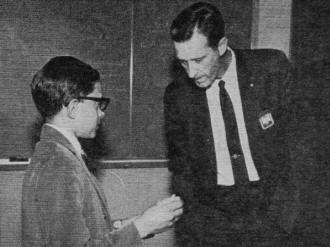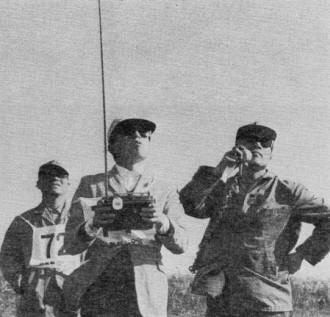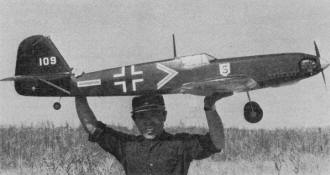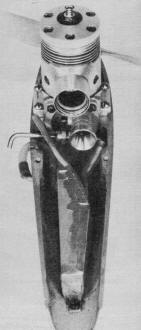|
Model rocketry was a big deal in the 1960's as
America and Russia pursued the great Space Race. The U.S.S.R. had effectively trumped
us by launching the
Sputnik a year before we put the
Explorer 1 into orbit. Yuri Gagarin made it into space before
Alan Shepherd blasted of atop the Mercury Redstone rocket in his
Freedom 7
capsule for a couple orbits around the earth. Boys (and a few girls) around the world
proudly referred to themselves as "rocketeers." Since the Academy of Model Aviation
(AMA) usually allocated space (no pun intended) for model rocket-relate news and
evens, it is no surprise that the sport was included in the "Model World on the
International Scene" features. Single-channel radio control (RC) also garnered a lot
of participation worldwide, since "multi" units were more expensive and required a
larger investment in time and money.
Model World on the International Scene
 Young Rocketeers Demonstrate for Space Scientists Young Rocketeers Demonstrate for Space Scientists
 Model rocketeers were honored by space scientists
during special ceremonies last October on the tenth anniversary of Sputnik. Five young
members of the National Association of Rocketry were special guests, cited as representing
"the wave of the future ... in space research." Greg Scinto, 15, of Stamford, Connecicut,
is shown discussing model rockets with H. W. Paige, Vice-President of the General Electric
Company's Missile and Space Division. Jim Kukowski supervises demonstration at G.E. host
site; Valley Forge, Pennsylvania. Model rocketeers were honored by space scientists
during special ceremonies last October on the tenth anniversary of Sputnik. Five young
members of the National Association of Rocketry were special guests, cited as representing
"the wave of the future ... in space research." Greg Scinto, 15, of Stamford, Connecicut,
is shown discussing model rockets with H. W. Paige, Vice-President of the General Electric
Company's Missile and Space Division. Jim Kukowski supervises demonstration at G.E. host
site; Valley Forge, Pennsylvania.
 U.S. Finals Site Shows New Trend for Indoor Meets U.S. Finals Site Shows New Trend for Indoor Meets
The 1968 U. S. Indoor team was selected last August at a fly-off in the Pompeian Court
of Northwood Institute in West Baden, Indiana. The court is similar to the Palace de Sport
in Rome, Italy, where the world championships will be held this year - almost 100 feet
high and over 200 feet in diameter. Indoor meets of old, usually held in big military
hangars, suffer in comparison: contestants slept in rooms looking out over the site.
AMA's CD, Chuck Borneman, marveled: "Imagine waking up and watching a mike job go serenely
past your window!"
SVAZARM Provides Government Support for Czech Modelers

Martin Dilly
Model flying in Czechoslovakia includes facilities and support for 200 clubs, provided
by SVAZARM, a government organization that runs such activities as gliding, swimming,
shooting, sailing, parachuting, flying and athletics, as well as other branches of modeling
such as slot racing and rocketry.
To a Westerner the support given to model flying seems unbelievable. At the recent
World Free Flight Championships at Sazena, the government supplied three helicopters
for model recovery, and the contest obtained for five consecutive days an average of
22 out of the 140 column inches of the sports page of Rude Pravo, the country's only
daily newspaper. Even at small contests the local party first secretary, the equivalent
of a mayor, will present the trophies, and the results will appear in the paper alongside
the football and other sports results. Can you visualize that in this country?
Single Channel RC in the Land of the Rising Sun


Lawrence Hoffman
The 2nd All-Japan Club RC Contest, Single Class, was held at the Marashino Air Self-Defense
Forces Parachute Training area. Eight clubs were entered, five men to a team. Due to
extremely heavy wind conditions flying time was increased to seven minutes from the five
normally allowed. The spot landing area was altered to include the 50-meter circle for
top points, and anywhere in the immediate area as the next lowest score. Highlights of
the contest were the splendid flying of the individual high scorers. On the right you
see Mr. Y. Kimura, age 14, from Tokyo, urging his bird along with a little hip "body-English."
Mr. Mimura was highest individual scorer and flew the Hope Star, low wing, ailerons only,
with an Enya .19 engine and Hinode single proportional radio. On the left is the winning
team, the Kobayashi RC Club, winners of last year's single class contest. From left to
right: Y. Kimura, holding the Hope Star described; Mr. T. Kobayshi, designer of the Hope
Star and several other fine flying planes. Mr. Kobayashi flew his biplane, the Silver
Star, but is shown holding his yet-to-be-released "Glory." Next in line is the younger
Tomei with his home-grown creation in front of him. His older brother is just behind
and on the extreme right is the team captain, Mr. Y. Ota. Mr. Ota flew the Victory C,
another Kobayashi bird; shoulder wing with ailerons and coupled rudder.
Officials Meet to Present Historical Model Display
 Dr. Walter Zaharevitz of National Aerospace Education
Council, Pat March from Cincinnati, Ohio, Bob Sauter of Silver Spring, Maryland, and James
H. Sage of Dallas, Texas, are shown listening as Sauter points out working details of
1908 Farman Biplane made by Carlysle Linskie of Irving, Texas. The occasion was a special
presentation held in Washington, D.C., under the joint auspices of the International
Plastic Model Society and the National Guard Association of the United States. Presented
was a collection of historical Air National Guard aircraft produced by I.P.M.S. modelers.
The collection was the result of a project initiated cooperatively by both groups to
obtain replicas of all aircraft flown by the Air National Guard from 1908 to the present.
Over sixty aircraft were modeled and contributed by I.P.M.S. members. A magnificent collection
indeed! Dr. Walter Zaharevitz of National Aerospace Education
Council, Pat March from Cincinnati, Ohio, Bob Sauter of Silver Spring, Maryland, and James
H. Sage of Dallas, Texas, are shown listening as Sauter points out working details of
1908 Farman Biplane made by Carlysle Linskie of Irving, Texas. The occasion was a special
presentation held in Washington, D.C., under the joint auspices of the International
Plastic Model Society and the National Guard Association of the United States. Presented
was a collection of historical Air National Guard aircraft produced by I.P.M.S. modelers.
The collection was the result of a project initiated cooperatively by both groups to
obtain replicas of all aircraft flown by the Air National Guard from 1908 to the present.
Over sixty aircraft were modeled and contributed by I.P.M.S. members. A magnificent collection
indeed!

Lawrence Hoffman
Tokyo-Built Messerschmitt
Hand-rubbed to a high gloss, this silk and dope finished semi-scale WW II Messerschmitt
is the result of much patience and unusual skill by its creator, Mr. Fujio Oka. Mr. Oka
designed and built the plane from scale pictures for Mr. Keiji Ishikawa, President, Japan
Steel Company, Tokyo. These gentlemen are members of the Tokyo Flyers Club, winners of
the First All-Japan Team RC Multi Class contest last year. Vital specs are: Radio is
Orbit, with fifth channel used for landing gear. Wing span is 190 cm, fuselage is 150
cm. Flying weight is 4.7 kg (10.3 lbs.), Engine is Fox .74. Main gear tires are locally
made by the MG Company. Model also has flashing wingtip and tail lights.
Close-up of a World Champion

Dale Kim
According to advertising on American television, "it's what's up front" that counts.
Here is a close look at Theobald & Wisniewski's TWA 2.5 cc engine from the rear.
This is the engine which Wisniewski used to win the FAI speed event for the U. S. at
the 1966 control-line world championships in England. Note exhaust opening, air intake
and the "suction" metal tank. Tuned exhaust pipe slips into exhaust opening after the
pan and engine are attached to the plane. The 1966 tuned pipe performance started a revolution
in international competition. European pipes dominated the Criterium of Aces control-line
meet last year, and the 1967 free-flight world championships was won with a tuned exhaust
engine from West Germany.
Posted March 30, 2018
|